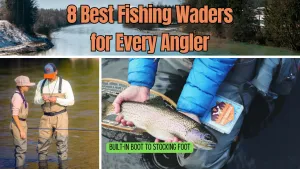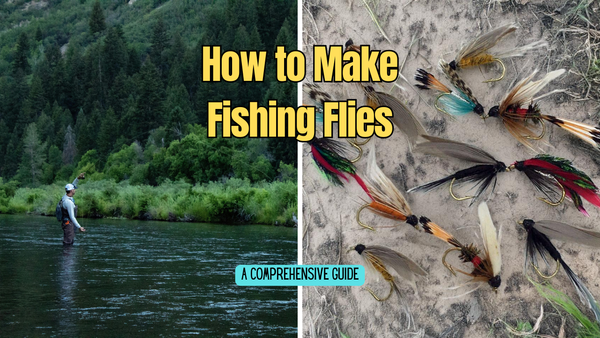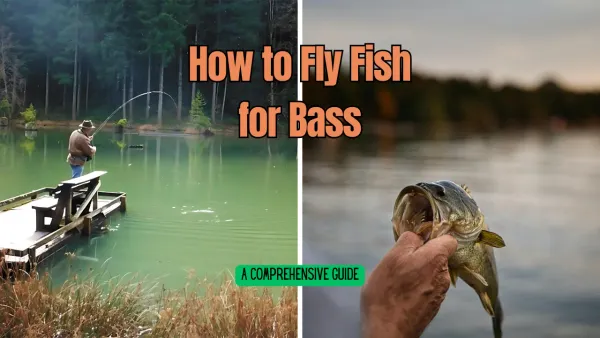Fly fishing is more than just a sport; it's an art form that connects you with nature. Unlike traditional fishing, fly fishing uses a lightweight lure called a fly to catch fish. This method requires skill, patience, and the right equipment. Whether you're a beginner or an experienced angler, this guide will help you master the art of fly fishing.
Key Takeaways:
- Understanding the Basics: Learn the essential gear and techniques to start fly fishing.
- Mastering Techniques: Develop skills in casting, choosing flies, and reading water.
- Advanced Tips: Explore advanced strategies for targeting specific fish and fishing in various environments.


The Essential Gear for Fly Fishing
Fly Rod
The fly rod is the backbone of your fly fishing setup. It's designed to cast lightweight flies and handle the unique challenges of fly fishing. When choosing a fly rod, consider the type of fish you want to catch and the environment you'll be fishing in. For trout fishing in small streams, a shorter rod is ideal. For larger fish in big rivers, a longer rod provides better control.
Fly Reel
The fly reel holds your fly line and helps you manage the fish once it's hooked. A good fly reel should have a smooth drag system to prevent the line from breaking. When selecting a reel, match it to your fly rod's weight and the type of fishing you'll be doing. For example, a reel designed for saltwater fishing will have different features than one for freshwater fishing.

Choosing the Right Fly Line
Floating Line
A floating line is the most versatile type of fly line. It stays on the water's surface, making it ideal for dry fly fishing. This type of line is perfect for beginners because it's easier to control and cast. Use a floating line when fishing for trout in rivers and streams.
Sinking Line
A sinking line is designed to sink below the water's surface, making it suitable for fishing in deeper waters. This type of line is often used for nymph fishing or when targeting fish that feed below the surface. Choose a sinking line when fishing in lakes or deep rivers.

Selecting the Perfect Flies
Dry Flies
Dry flies imitate insects that land on the water's surface. They are perfect for catching fish that feed on the surface, such as trout. Popular dry flies include the Elk Hair Caddis and the Adams. Use dry flies when you see fish rising to the surface to feed.
Nymphs
Nymphs mimic the immature stages of aquatic insects. They are fished below the surface and are effective for catching fish that feed in the water column. Common nymph patterns include the Hare's Ear and the Pheasant Tail. Use nymphs when fish are not actively feeding on the surface.
Understanding Fly Casting
Basic Fly Cast
The basic fly cast is the foundation of fly fishing. It involves a smooth back-and-forth motion to propel the fly line and fly. Start with a short line and practice your timing and rhythm. Focus on keeping your wrist firm and using your arm to generate power.
Roll Cast
The roll cast is useful when you have limited space for a backcast. It involves rolling the line out over the water's surface. This cast is particularly effective in small streams with overhanging trees. Practice the roll cast to improve your versatility as a fly fisher.

Reading the Water
Identifying Feeding Fish
To catch fish, you need to know where they are feeding. Look for signs of fish activity, such as rising fish or bubbles on the water's surface. Fish often feed in areas with abundant food, such as undercut banks or near rocks. Use polarized sunglasses to reduce glare and see fish below the surface.
Understanding Water Currents
Water currents play a crucial role in fly fishing. Fish often position themselves in areas where the current brings food to them. Look for seams, where fast and slow currents meet, as these are prime feeding spots. Cast your fly upstream and let it drift naturally with the current.
Fly Fishing Techniques
Dry Fly Fishing
Dry fly fishing involves casting a fly that floats on the water's surface. This technique is exciting because you can see the fish take the fly. Use a floating line and a dry fly, such as the Elk Hair Caddis. Cast your fly upstream and let it drift naturally with the current.
Nymph Fishing
Nymph fishing targets fish that feed below the surface. Use a sinking line and a nymph pattern, such as the Hare's Ear. Cast your fly upstream and let it sink to the desired depth. Watch your line for any movement, as this indicates a fish has taken the fly.

Advanced Fly Fishing Strategies
Targeting Specific Fish
Different fish species require different strategies. For example, trout are often found in cold, clear streams, while bass prefer warmer, murkier waters. Research the habits and habitats of your target fish to increase your chances of success. Use flies and techniques that mimic the natural food sources of your target fish.
Fishing in Various Environments
Fly fishing can be done in a variety of environments, from small streams to large rivers and lakes. Each environment presents unique challenges and opportunities. In small streams, stealth and precision are key. In large rivers, long casts and powerful rods are necessary. Adapt your techniques and gear to the environment you're fishing in.
Fly Fishing for Beginners
Starting Slow
If you're new to fly fishing, start slow and focus on the basics. Practice your casting in an open area before hitting the water. Learn to tie basic knots, such as the improved clinch knot and the loop knot. Take your time and enjoy the learning process.

Choosing the Right Equipment
As a beginner, it's important to choose the right equipment. Start with a versatile fly rod and reel combo that matches the type of fishing you plan to do. Invest in quality gear, such as a good pair of waders and polarized sunglasses. Visit fly shops for expert advice and recommendations.
Fly Fishing for Experienced Anglers
Advanced Casting Techniques
Experienced anglers can benefit from mastering advanced casting techniques. The double haul cast, for example, allows you to cast longer distances with greater accuracy. Practice this technique to improve your casting skills and reach fish that are farther away.
Exploring New Waters
Experienced anglers often seek new challenges by exploring different waters. Try fishing in saltwater environments or targeting different species, such as salmon or steelhead. Each new environment offers unique experiences and opportunities to improve your skills.
Fly Fishing Gear Maintenance
Cleaning Your Gear
Proper maintenance of your fly fishing gear is essential for its longevity. After each fishing trip, clean your rod, reel, and line with fresh water to remove dirt and debris. Dry your gear thoroughly before storing it to prevent mold and corrosion.
Storing Your Gear
Store your fly fishing gear in a cool, dry place to prevent damage. Use a rod tube to protect your fly rod and a reel case for your fly reel. Keep your flies organized in a fly box and store them in a dry, ventilated area.

Fly Fishing Safety Tips
Wearing Proper Gear
Safety is paramount when fly fishing. Wear a good pair of waders to protect yourself from cold water and sharp objects. Use polarized sunglasses to protect your eyes from the sun and improve your visibility. Always wear a hat and sunscreen to protect yourself from UV rays.
Being Aware of Your Surroundings
Always be aware of your surroundings when fly fishing. Watch out for slippery rocks, fast currents, and other hazards. If you're fishing in a remote area, let someone know your plans and carry a first aid kit. Stay safe and enjoy your time on the water.
Fly Fishing Etiquette
Respecting Other Anglers
Fly fishing is a social sport, and it's important to respect other anglers. Give other fishers plenty of space and avoid crowding their fishing spots. If you see someone struggling, offer assistance or advice. Fly fishing is about community and camaraderie.
Protecting the Environment
As a fly fisher, you have a responsibility to protect the environment. Practice catch and release to preserve fish populations. Avoid damaging vegetation and be mindful of your impact on the ecosystem. Leave no trace and help keep our waters clean and healthy.
Fly Fishing in Different Seasons
Spring Fly Fishing
Spring is a fantastic time for fly fishing, as fish become more active after the winter months, responding to the warming temperatures and increased food availability. During this season, the water begins to thaw, and fish emerge from their winter lethargy, making them more eager to feed. Using nymphs and streamers is particularly effective for targeting fish that are feeding below the surface. Nymphs imitate the immature stages of aquatic insects, which are abundant in the spring, while streamers mimic small fish and other prey, appealing to larger, predatory fish.
Summer Fly Fishing
Summer offers excellent dry fly fishing opportunities, presenting anglers with some of the most enjoyable and visually exciting fishing experiences of the year. During this season, fish are often found in deeper, cooler waters during the heat of the day to escape the warm surface temperatures. However, they frequently rise to the surface to feed on various insects and terrestrials, such as grasshoppers, ants, and beetles.

Fall Fly Fishing
Fly fishing in the fall is a rewarding experience as cooler temperatures and changing foliage create a picturesque backdrop. During this season, trout and other species become more active, feeding heavily to prepare for winter. Insects like midges, mayflies, and caddisflies are still prevalent, making them excellent choices for fly patterns. Streamers and nymphs also work well as fish seek out larger meals. Fall offers a quieter, more serene fishing environment with fewer anglers on the water. This time of year requires adapting to shorter days and varying water conditions, but the potential for catching larger, more aggressive fish makes it worthwhile.
Fly Fishing in Different Waters
River Fly Fishing
Rivers provide diverse habitats for fly fishing. Look for fish in riffles, pools, and undercut banks. Use a variety of flies and techniques to match the conditions. Pay attention to water levels and currents, as they can change rapidly.
Lake Fly Fishing
Lakes offer unique challenges and opportunities for fly fishing. Fish are often found in deeper waters, so use sinking lines and weighted flies. Look for fish near structures, such as rocks and submerged trees. Long casts and patience are key to success in lakes.
Fly Fishing for Trout
Understanding Trout Behavior
Trout are one of the most popular targets for fly fishers. They are often found in cold, clear streams and rivers. Trout feed on a variety of insects, so matching the hatch is crucial. Pay attention to the insects in the water and use flies that mimic them.
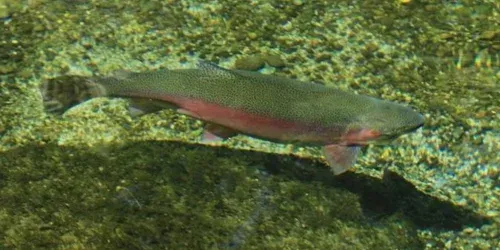
Best Flies for Trout
Some of the best flies for trout include the Elk Hair Caddis, Adams, and Wooly Bugger. Dry flies are effective for surface-feeding trout, while nymphs and streamers work well for fish feeding below the surface. Experiment with different patterns to see what works best.
Fly Fishing for Bass
Targeting Bass
Bass are aggressive predators that provide exciting fly fishing opportunities. They are often found in warm, murky waters with plenty of cover. Use large, flashy flies to attract their attention. Cast near structures, such as rocks and fallen trees, where bass like to hide.

Best Flies for Bass
Some of the best flies for bass include poppers, streamers, and large nymphs. Poppers create a commotion on the water's surface, attracting bass from a distance. Streamers mimic baitfish and are effective for subsurface fishing. Experiment with different flies to see what works best.
Fly Fishing for Salmon
Understanding Salmon Behavior
Salmon are powerful fish that migrate from the ocean to freshwater rivers to spawn. They are often found in fast-moving waters with plenty of oxygen. Use large, bright flies to attract their attention. Pay attention to the timing of the salmon run for the best chances of success.

Best Flies for Salmon
Some of the best flies for salmon include the Egg Sucking Leech, Intruder, and Spey flies. These flies are designed to mimic the natural food sources of salmon. Use a sinking line and heavy tippet to handle the powerful runs of these fish.
Fly Fishing in Streams
Targeting Stream Fish
Streams provide diverse habitats for fly fishing. Look for fish in riffles, pools, and undercut banks. Use a variety of flies and techniques to match the conditions. Pay attention to water levels and currents, as they can change rapidly.
Best Flies for Streams
Some of the best flies for streams include the Elk Hair Caddis, Adams, and Hare's Ear Nymph. The Elk Hair Caddis is a highly buoyant dry fly that excels at mimicking adult caddisflies, making it a favorite for enticing surface-feeding trout. The Adams is a versatile dry fly that imitates a variety of mayflies, making it effective in many stream conditions and a staple in any angler's fly box. The Hare's Ear Nymph is an excellent choice for subsurface fishing, as it imitates a wide range of aquatic insects, particularly mayfly nymphs.
Dry flies like the Elk Hair Caddis and Adams are effective for surface-feeding fish, as they float on the water's surface and resemble adult insects. These flies are particularly useful during hatches when fish are actively feeding on emerging insects. Nymphs and streamers, such as the Hare's Ear Nymph, work well for fish feeding below the surface. Nymphs imitate the immature stages of aquatic insects, while streamers often mimic small baitfish or leeches.
Experiment with different patterns, sizes, and colors to see what works best for the specific conditions of the stream you are fishing. Factors such as water clarity, flow rate, and the presence of natural insects can all influence which flies are most effective. Additionally, observing the behavior of the fish and the types of insects in the environment can provide valuable clues for fly selection. By varying your approach and being adaptable, you can increase your chances of success on the water.
Fly Fishing in Large Rivers
Targeting River Fish
Large rivers offer unique challenges and opportunities for fly fishing. Fish are often found in deeper waters, so use sinking lines and weighted flies. Look for fish near structures, such as rocks and submerged trees. Long casts and patience are key to success in large rivers.
Best Flies for Large Rivers
Some of the best flies for large rivers include the Wooly Bugger, Clouser Minnow, and Stonefly Nymph. These flies are effective for a variety of river species such as trout, bass, and salmon. The Wooly Bugger is versatile and can imitate a range of prey, including minnows and leeches. The Clouser Minnow is excellent for mimicking baitfish and works well in deeper, faster currents. The Stonefly Nymph is particularly effective during stonefly hatches and is known for its ability to attract larger fish.
Experiment with different patterns and colors to match the local insect population and water conditions. Adjusting the size and weight of the flies can also help you reach the right depth and improve your chances of a successful catch.
Fly Fishing in Lakes
Targeting Lake Fish
Lakes offer unique challenges and opportunities for fly fishing. Fish are often found in deeper waters, so use sinking lines and weighted flies. Look for fish near structures, such as rocks and submerged trees. Long casts and patience are key to success in lakes.
Best Flies for Lakes
ome of the best flies for lakes include the Wooly Bugger, Clouser Minnow, and Chironomid. These flies are effective for targeting a variety of lake species and are versatile for different fishing conditions.
The Wooly Bugger is a classic fly that mimics leeches, minnows, and crayfish, making it ideal for trout, bass, and panfish. Its adaptable design allows for fishing at various depths and in different sizes and colors.
The Clouser Minnow, with its weighted eyes and lifelike movement, is excellent for predatory fish like bass, pike, and walleye. It effectively imitates small baitfish and can be used in both shallow and deep water.
The Chironomid, or midge, is essential for trout fishing in lakes, mimicking the life stages of these insects. Though requiring delicate presentation, it can be highly effective, especially during hatches.
Experimenting with different fly patterns, retrieval speeds, depths, and presentations is key to success. Observing local insect activity and matching the hatch can also improve your chances. Using various lines can help you cover different parts of the water column.
By diversifying your fly selection and tactics, you can target a wide range of lake species and enhance your fishing experience. Understanding the ecosystem and being adaptable is crucial for a productive outing.
Fly Fishing in Ponds
Targeting Pond Fish
Ponds offer a more relaxed fly fishing experience. Target species such as bluegill, bass, and crappie. Use small, lightweight flies that mimic insects and small baitfish. Cast near structures, such as lily pads and fallen trees, where fish like to hide.
Best Flies for Ponds
When fishing in ponds, selecting the right fishing flies can make a significant difference in your success. Among the top choices are the Wooly Bugger, Pheasant Tail Nymph, and Foam Beetle.
The Wooly Bugger is a versatile fly that mimics various aquatic creatures like leeches, minnows, and crayfish. Its pulsating action in the water attracts a wide range of pond species, including bass, bluegill, and trout.
The Pheasant Tail Nymph is another excellent option, designed to imitate the nymph stage of various aquatic insects. Its realistic appearance and movement make it particularly effective for targeting species such as bluegill and crappie.
The Foam Beetle, with its buoyant body and realistic silhouette, is perfect for surface fishing. This fly can entice strikes from fish feeding on the surface, making it a favorite for catching panfish and other species that frequent the top layers of the pond.
To maximize your fishing experience, it’s important to experiment with different fly patterns and techniques. Varying your retrieval speed, depth, and presentation can help you determine what works best in different conditions and for different species. By doing so, you’ll be able to adapt to the specific preferences of the fish in your pond, ultimately leading to a more successful and enjoyable fishing outing.
Fly Fishing in Saltwater
Targeting Saltwater Species
Saltwater fly fishing offers unique challenges and opportunities. Target species such as bonefish, tarpon, and redfish in coastal waters. Use large, durable flies that can withstand the harsh saltwater environment. Pay attention to tides and currents for the best chances of success.
Best Flies for Saltwater
Some of the best flies for saltwater fishing include the Clouser Minnow, Crazy Charlie, and Deceiver. These flies are specifically designed to mimic the appearance and movement of bait fish and crustaceans, which are primary food sources for many saltwater species.
The Clouser Minnow is renowned for its versatility and effectiveness. Its weighted eyes give it a distinctive jigging action, making it an excellent choice for targeting a variety of saltwater fish, including striped bass, redfish, and bonefish. This fly’s ability to imitate small baitfish and its dynamic movement in the water column make it a staple in any saltwater angler's fly box.
The Crazy Charlie, originally designed for bonefish, is another essential fly. Its subtle yet lifelike profile mimics shrimp and small crustaceans, making it highly effective for not only bonefish but also permit and other flats species. The fly's construction allows it to sink quickly and stay in the strike zone, increasing your chances of a successful catch.
The Deceiver, developed by legendary fly tier Lefty Kreh, is celebrated for its realistic baitfish imitation. Its long, flowing feathers create lifelike movement, attracting predatory fish such as tarpon, snook, and bluefish. The Deceiver’s durability and effectiveness across various saltwater environments make it a go-to pattern for many anglers.
When targeting powerful saltwater fish, it’s crucial to use a heavy-duty fly rod and reel. Saltwater species are known for their strength and speed, often making long, hard runs that can test your equipment to its limits. A robust rod with a strong backbone and a reel with a smooth, reliable drag system will help you handle these powerful fish and increase your chances of landing them successfully.
Overall, the combination of these well-designed flies and sturdy equipment will enhance your saltwater fishing experience, allowing you to effectively mimic the prey that saltwater species feed on and withstand the intense battles that come with saltwater fishing.
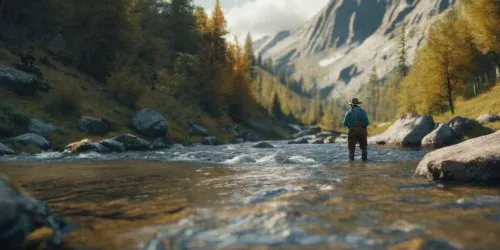
Conclusion
Fly fishing is a rewarding and immersive experience that connects you deeply with nature. By understanding the basics of fly fishing gear, mastering casting techniques, and learning to read the water and the behavior of fish, you can significantly enhance your chances of success. Remember to start with versatile flies like the Elk Hair Caddis, Adams, and Hare's Ear Nymph, and be willing to experiment with different patterns and strategies.
Patience and practice are key to becoming proficient in fly fishing. Each trip to the water offers new opportunities to learn and improve. Whether you are seeking the tranquility of a mountain stream or the challenge of a large river, the skills you develop in fly fishing will provide endless enjoyment and a deeper appreciation for the aquatic ecosystems you explore.
So grab your gear, head to your favorite fishing spot, and enjoy the art and adventure of fly fishing. Tight lines and happy fishing!

FAQs
What is the best time of day to fly fish?
Early morning and late evening are ideal times for fly fishing because fish are more active and insects are more abundant on the water during these cooler periods.
What gear do I need to start fly fishing?
You'll need a fly rod (9-foot, 5-weight for beginners), fly reel, weight-forward floating fly line, backing, leader, flies (dry, wet, nymphs, streamers), waders, boots, and accessories like a fly box, nippers, forceps, landing net, and polarized sunglasses.
How do I choose the right fly for the water I'm fishing?
Match your fly to the local insects you observe, consider the season's hatches, and choose flies based on water type (small fish/larger insects for still water; nymphs/streamers for moving water). Experiment with different flies if needed.




